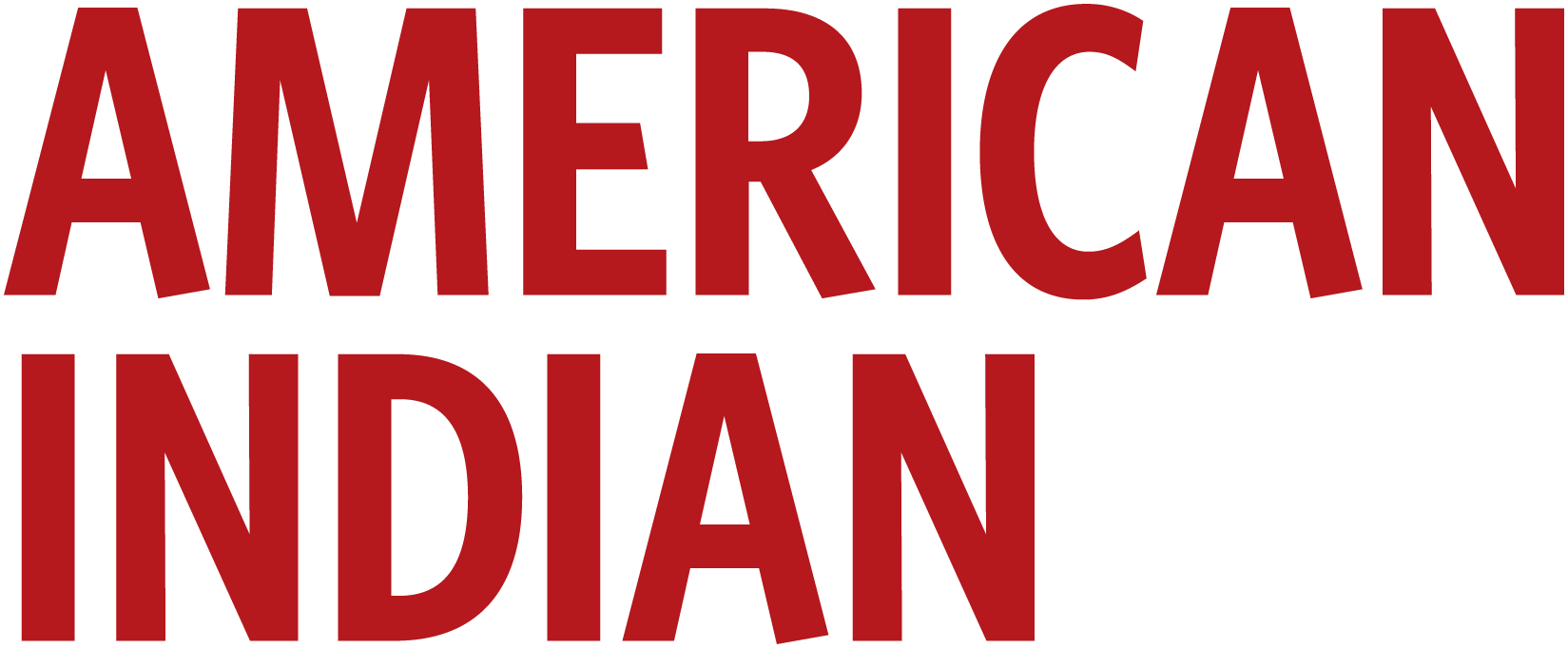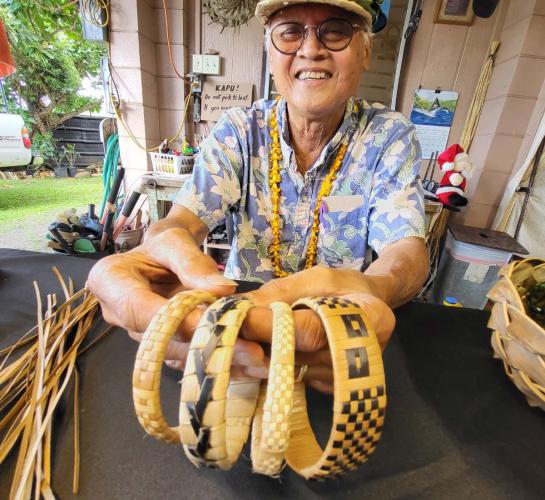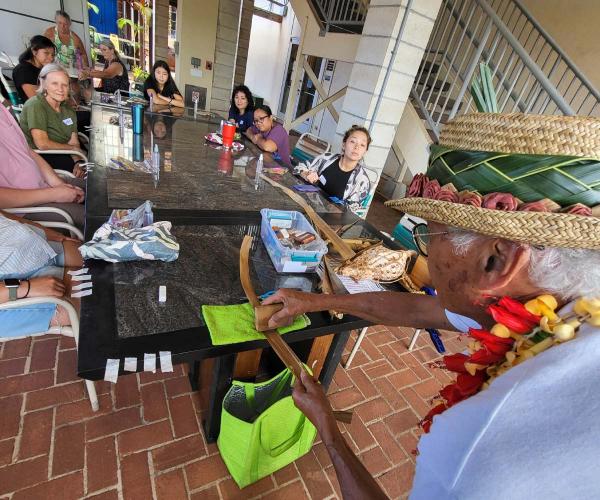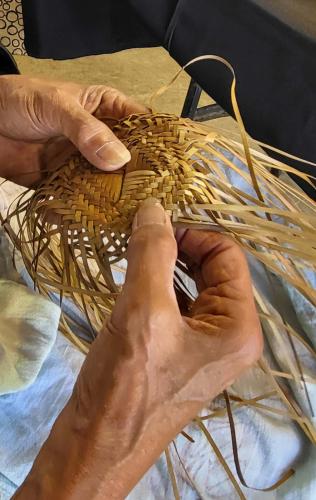Last summer, about a dozen visitors gathered at the Kaua‘i Museum in Līhu‘e, Hawai‘i, to learn “ulana lauhala,” or the weaving of leaves from hala trees. This ancient technique has produced everything from household items such as baskets to sails on vessels that carried Polynesians from the Marquesas Islands some 2,500 miles to the Hawaiian Islands more than 1,000 years ago.
“We used to weave as a necessity for our homes,” said Maile Andrade, a multimedia artist and retired professor at the Kamakakūokalani Center for Hawaiian Studies at the University of Hawai‘i–Mānoa on O‘ahu. “Now we weave for another necessity, which is to bring our culture back and to relate to our ancestors,” she said.
As cloth made of cotton and other materials became available when Europeans arrived in the Hawaiian Islands during the late 18th century, hala tree leaves and the skill needed to weave them became less in demand. Andrade said many of the lauhala items produced in Kona on the “Big Island” of Hawai‘i during the 1920s through 1940s were done so for trade with coffee plantations. “They would bring their stuff to the store and trade it for sugar, flour and groceries,” she explained. “Ulana lauhala became important for the family to survive. But the way they learned how to weave was within the family.”
Andrade said to help her reconnect to her ancestors, she will visit her peoples' items in museums. “These objects are our ancestors. When you pick up an old basket, you are learning from it. That ancestor is talking to you,” she said. “When I am weaving, I’m thinking about that person and that time and it reconnects me to this place now.”
Because neither Andrade’s Native Hawaiian mother or Chinese father were weavers, she sought out master teachers during the time of cultural revival on the islands known as the “Hawaiian Renaissance” in the 1970s. “They realized that if they didn’t teach, the practice would be lost,” she said, adding that cultural knowledge is not necessarily inherent, but rather something that is learned. She said, “I consciously chose to be an artist and to practice my culture.”
Ulana lauhala is considered sacred knowledge. To preserve it, some instructors have chosen to teach the technique to both Native Hawaiian and non-Native individuals. The Kaua‘i Museum frequently offers ulana lauhala workshops for all its visitors.
As is done in many traditional Hawaiian gatherings and ceremonies, instructor Eugene Onio Punzal began the weaving workshop at the museum by blowing a Pū, or conch shell horn. Its bellowing hum was then followed by a group chant titled “Mele Oli Aloha No Kaua‘i (“A Love Song for Kaua‘i”) to honor the sun and the land.
Once the ceremony was complete, Punzal began flattening, stripping and cutting 3-foot-long hala leaves. His modern tools included a pasta maker equipped with a tiny row of blades to separate the narrow strands for weaving. “Back in the day we wouldn’t have these machines,” he reminded the students. Traditional tools would have included seashells to cut the leaves and stones to hold their strands down while weaving them.
About 600 species of hala exist in coastal areas ranging from Hawai‘i to West Africa. In Hawai‘i, the hala species Pandanus tectorius grows wild along its beaches. But it is vulnerable to invasive insects such as the hala scale insect that was introduced to Maui in 1999.
Even though the hala species that have thorns are more durable, for his class, Punzal said he chose leaves without thorns because they are “easier to work with.” The students made their bracelets from two different kinds of hala, a dark brown plant from Samoa and a light brown one gathered on Kaua‘i. The small strands were moistened constantly with water to keep them pliable. The intersecting strands have names in the Hawaiian language: the “moe” are the “lying down,” or “sleeping” strands that wrap flat around and through the “kū” strands, which alternate above and below the “moe” and are said to be “standing up.”
Punzal, who was born in Hawai‘i and is of Filipino decent, is one of the non-Native residents who have learned and are passing on this technique. He began learning how to weave coconut leaf hats, or “launiu,” but eventually turned to weaving hala leaves 12 years ago. In addition to learning from other teachers, he studied for three years under Andrade.
Punzal has since served on the board of the Malie Foundation, a scholarship-granting institution geared toward the preservation and perpetuation of Hawaiian culture. He has been demonstrating ulana lauhala at the museum for nearly three years. There, he and his Native Hawaiian assistants—Leslie Scales, Noe Mahi and Kanani Kaye—call their group the “ulana ‘ohana,” or “weaving family.” At the workshop, they bustled around helping students who were attempting to learn the painstaking practice.
“This is a ‘kuleana,’ or responsibility, we all share,” said Mahi (who passed away after being interviewed). “Uncle Onio is our ‘kumu ulana,’ or weaving teacher. When he goes, his craft goes with him.”
“When I first started these classes, they were designed for tourists,” he said. “But now 70 percent of the participants are locals because there are no other opportunities to learn this. People tell me their grandmother used to weave lauhala, and they wished they had learned also. Some people still have the tools for doing this, but they don’t know how to use them. The museum classes have become a new opportunity to learn how.”
“Onio is reaching people that I can’t reach, and he is doing a service for us,” said Andrade, who joins about 40 weavers virtually or in person to weave together every few months. She said, “If I am teaching a Native person, I am teaching a certain way. If I am teaching others, I teach them how to see like a Native Hawaiian, to know where this cultural practice is coming from.”
Andrade has recently learned how to make the sails from master weaver Pōhaku Kaho‘ohanohano and gathered a group of weavers to create one that can be attached to a traditional canoe that she can sail from Kaua‘i, just like the first voyagers to land on the Hawaiian islands. “I teach my students it’s not about the individual but about the village,” Andrade said. “By practicing our culture together, we are honoring our ancestors.”



